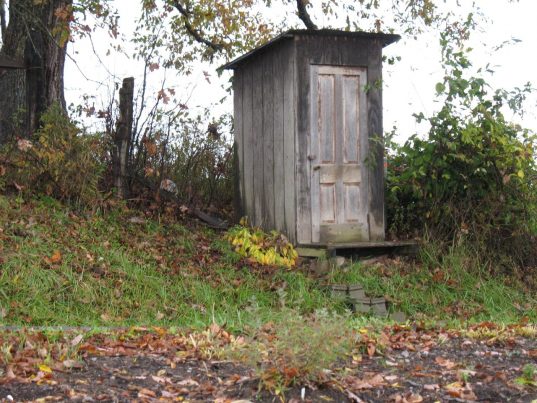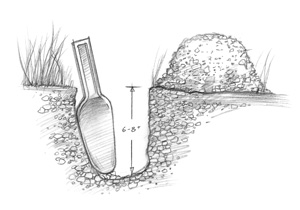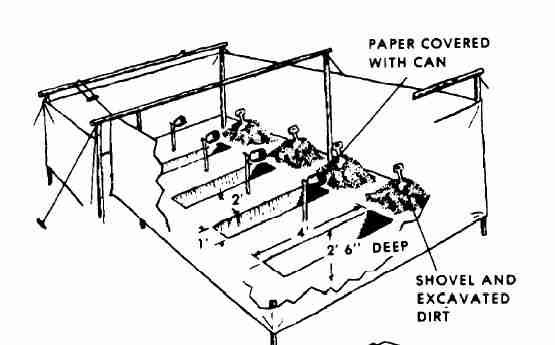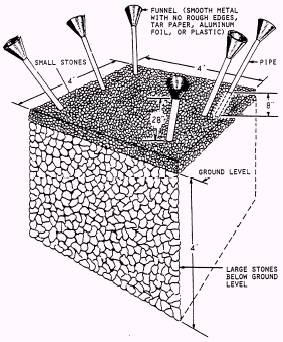How to build ‘bathroom facilities’ that will keep you safe and healthy
Thursday, February 18, 2016 by usafeaturesmedia
http://www.bugout.news/2016-02-18-how-to-build-bathroom-facilities-that-will-keep-you-safe-and-healthy.html

(Bugout.news) Just because society has collapsed doesn’t mean your bladder and your bowels stop working. We may not like to talk about it in polite company, but it’s true.
In fact, if you drink the wrong water or eat the wrong food, your bowels are going to exact revenge on you big time. But even under normal, non-infectious conditions, regular bodily functions will make it imperative that you design and build proper “bathroom facilities” that won’t make you and your party sick by inviting and spreading disease.
So it will become imperative for you and your group to construct adequate field bathroom facilities that you can manage well, that are effective and as sanitary as you can make them so that you don’t attract disease.
According to military guidelines, latrines must be built to prevent contamination of food and water. They should be constructed at least 100 yards downwind and down gradient from your food preparation site, and at least 100 feet from any ground water source like a pond or stream.
Never place your field latrine above gradient of the food preparation site, and for additional protection, don’t dig your latrine at the ground water level or in places where the contents of the latrine pit can drain into the water source [we can’t stress this enough!].
The goal is to build your latrine far enough away from vital living spaces but yet close enough for easier access. And you should also dig a drainage ditch around the edges of the latrine to keep rainwater and other surface water out.
In addition, you should place some sort of hand-washing system outside of each latrine area, and make sure everyone washes their hands after using the latrine, to cut down on chances of spreading contamination.
As noted by Army Study Guide:
When a latrine is filled to within 1 foot (30 centimeters) of the ground surface or when it is to be abandoned, it is closed in the following manner. The pit is filled to the ground surface in 3-inch (8-centimeter) layers; each layer is compacted. This is to prevent fly pupae from hatching and gaining access to the open air. Dirt is then compacted over the pit to form a mound at least 1-foot (30-centimeters) high.
On the run, or when you’re in a temporary bivouac area, you can use your emergency shovel to dig a “cat hole” – a hole about 1 foot deep that is completely covered after use. These are generally dug when you have to have a bowel movement. A quick tip: Never, ever urinate into a stream or other water source.

When you’re in an area where you plan to hole up, the best solution is to dig a latrine system, and one that will accommodate both male and female members.
Straddle-trench latrine
Dig a trench 1-foot wide, 2 ½ feet deep, and 4 feet long, allowing two feet of length per person. These trenches should be built parallel to one another and spaced at least two feet apart. Since there are not seats for this type of latrine, you can place boards along both sides of the trench to provide better footing.
As the trench is begin dug, place the dirt at one end of the trench; leave a shovel or other device at the site so that the user can quickly cover excrement after he or she is through. If you have a supply of toilet paper, stick a stout tree branch in the ground and slip a roll onto one of the branches, to keep it off the ground. Protect the paper from bad weather with a suitable covering (tin can, plastic, etc.). When you close the straddle trench, use the method described above.

Deep pit latrine
This latrine is most often used with a two-seat box (four feet long, 2 ½ feet wide at the base and 18 inches high) that serves as a makeshift toilet. Dig your trench pit wide enough to accommodate excrement deposits but leave enough room for the box to be able to rest on solid ground.
“As a guide, a depth of 1 foot (30 centimeters) is allowed for each week of estimated use, plus 1 foot (30 centimeters) of depth for dirt cover,” Army Study Guide notes. “Generally, it is not desirable to dig the pit more than 6-feet (2-meters) deep because of the danger of the walls caving in. Rocks or high ground water levels may also limit the depth of the pit.”
In order to reduce the presence of flies, keep the latrine box lids closed, seal any cracks in the wood and keep the area clean. This will also cut down on odors.
And if you have the materials, always consider putting up a privacy fence of sorts – this can be an actual wooden structure, tarps, blankets, etc.

Urine disposal
There are a few good ways to properly dispose of urine.
Urine Soakage Pit: This is probably the best improvised device for field disposal of urine. Dig a pit four feet square and four feet deep. Fill most of it with an aggregate material, such as medium-sized stones. Place a border around each edge so that each side of the soakage pit is five feet long; make the border six inches wide and four inches deep. Then fill that border and the rest of the pit with smaller stones.
The key, however, is to not urinate directly on the small stones. Use some sort of device to make a pipe and insert that about eight inches into the pit; the pipe should extend about 30 inches upward and at an angle.

Trough urinal: This is generally associated with a more permanent facility, as it will require a bit more material to construct. “The U- or V-shaped trough is about ten feet long and made of sheet metal or wood. If wood is used, it must be lined with heavy tar paper. The legs supporting the trough are cut slightly shorter on one end where a pipe carries the urine into the soakage pit or latrine pit,” says the Army’s latrine field manual.
Also note that besides flies, rodents are also attracted to waste disposal areas.
Bugout.news is part of the USA Features Media network of sites.

